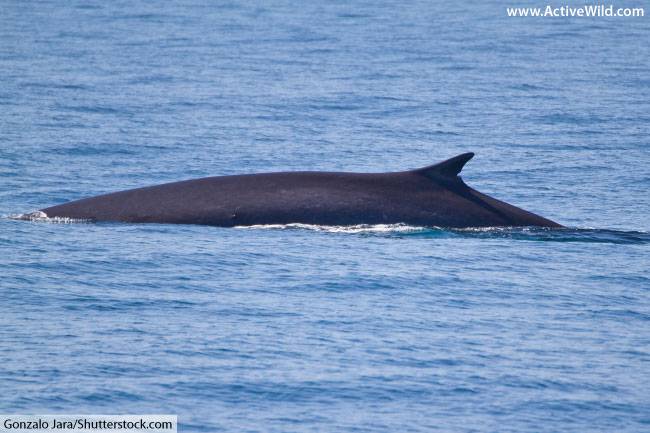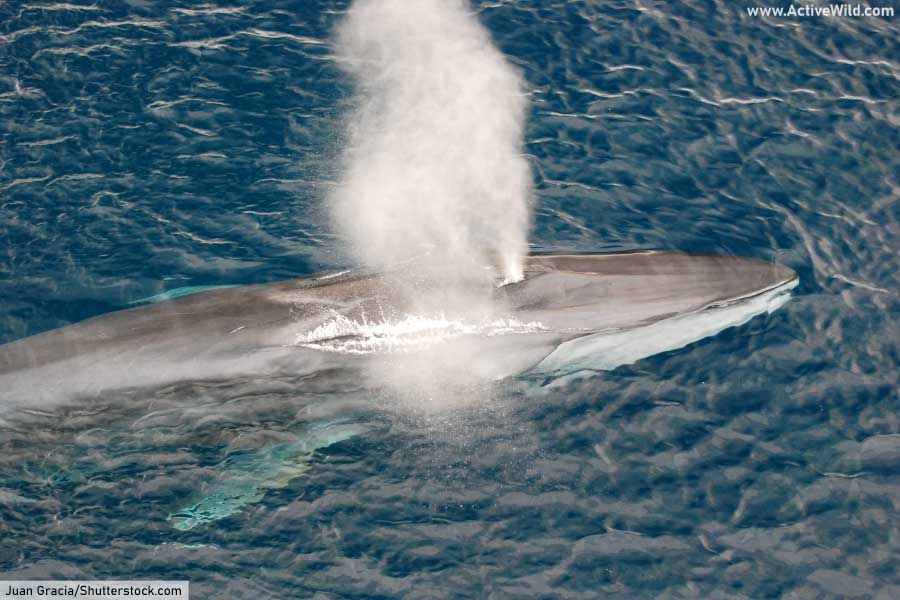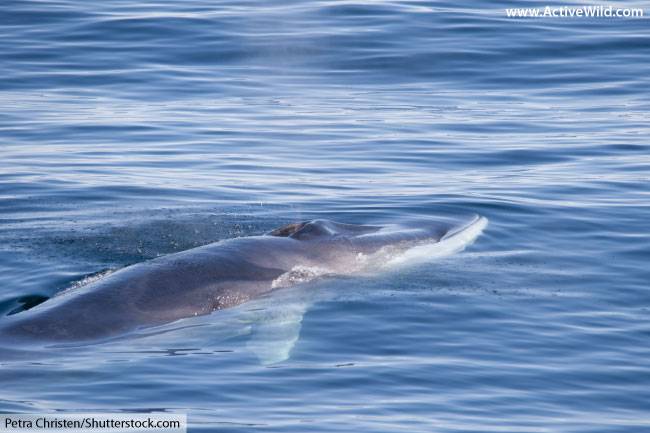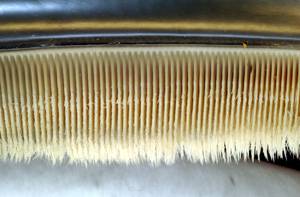
Fin whale facts, pictures, video & in-depth information: discover the second largest animal in the world! (Check out the video of a close encounter with a fin whale to get an idea just how big this animal is!)
Fin Whale Quick Facts
- Other Name(s): Common Rorqual, Finback, Fin-backed Whale, Finner, Herring Whale, Razorback
- Scientific name: Balaenoptera physalus
- Type of Animal: Mammal
- Animal Family: Balaenopteridae
- Where Found: Oceans worldwide
- Average Length Northern Hemisphere: male 18.5m (61ft), female 20m (66ft); Southern Hemisphere: male 20.5m (67ft, female 22m (72ft)
- Weight Northern Hemisphere: male 38.5 tonnes (42.5 tons), female 50.5 tonnes (55.5 tons); Southern hemisphere: male 52.5 tonnes (58 tons) and female 63 tonnes (69.5 tons)
- Conservation Status: Endangered

Fin Whale Fun Facts
- The spout of the fin whale is shaped like an inverted cone and is between 4.5 to 6m (15 to 20ft) high.
- The fin whale is the second largest animal in the world; only the blue whale is larger!
- The fin whale’s name comes from its distinctive dorsal fin.
- The colors of a fin whale’s head aren’t symmetrical; an unusual feature in the animal world (check out the overhead view further down the page).
Meet The Fin Whale: Introduction
The fin whale is the second largest animal in the world after the blue whale. (The fin whale is therefore also the second largest mammal in the world).
The longest recorded fin whale measured 27.3m (89.6ft) and the heaviest weighed nearly 74 tonnes (82 tons). The fin whales in the Southern Hemisphere are larger than those in the Northern Hemisphere.
You can see a list of ALL living whales on this page: Types of Whales
Close Encounter With A Fin Whale
You can get an idea of the fin whale’s size in the video below:
Subspecies & Related Animals
Two subspecies of fin whale with distinct physical features and vocalizations are recognized: the northern fin whale (B. physalus physalus), found mainly in the North Atlantic, and the southern fin whale (P. physalus quoyi), found in the Southern Ocean.
A third subspecies, the pygmy fin whale (B. physalus patachonica) has been suggested, but is not currently officially recognized.
The fin whale is in the family Balaenopteridae. Members of this family are also known as rorqual whales, or just rorquals. Rorquals have long ridges in their skin running from their mouths to their chests. The ridged skin allows the whales’ mouths to expand when eating.
Other rorquals include the blue whale, humpback whale, and the common minke whale.
What Does The Fin Whale Look Like?

The fin whale is more streamlined than other rorquals. It has a flat, V-shaped head with paired blowholes, a ridged back (the source of its nickname ‘razorback’), a curved dorsal fin, tapered flippers and a wide tail fin. Being a rorqual, it has between 56 and 100 pleats or grooves in its skin which extend from below the mouth to the navel.

The back of the fin whale is light to dark brownish-gray, while the underside and the flippers are white. A curious feature is the asymmetrical coloration of the head: the left side is uniformly gray while the right side has white markings. It’s suspected that the asymmetrical pigmentation might play a role in hunting.
Fin Whale Facts: Distribution And Migration
The fin whale inhabits all the major oceans worldwide from tropical to polar waters. It is most often found in temperate and cool offshore waters.
It’s thought that most fin whale populations are migratory and swim to subtropical waters during the winter for mating and to the colder waters of the Arctic and Antarctic during the summer for feeding. Some populations are resident year-round in areas like the Gulf of California and the Mediterranean.
Movement
The fin whale is one of the fastest cetaceans in the world. It has been nicknamed ‘the greyhound of the sea’ on account of its streamlined shape and high speed.
The fin whale can swim as fast as 56km/h (29mph) in short bursts, and can sustain a speed of between 37km/h (23mph) and 41km/h (25mph) over longer periods.
Social structure
Compared to other rorquals, the fin whale is more gregarious (social) and can often be found in pairs or small groups of up to 10 individuals.
Aggregations (groups) of over 100 fin whales have been recorded at feeding grounds. The social structure seems to depend largely on the availability of food.
Fin Whale Facts: Breeding
The fin whale mates during the winter months. The female gives birth – typically to a single calf – at 2 or 3 year intervals after a gestation period of 11 to 12 months.
A newborn calf measures 5.5 to 6.5m (19.7 to 21.3ft). It length will have doubled by the time it has weaned at around 6 months of age. The calf follows its mother to the summer feeding grounds and stays with her for a year.
Matings between fin whales and blue whales are known to occur, producing hybrids.
Vocalization
Alongside the vocalizations of the blue whale, the sounds emitted by the fin whale are the lowest-frequency animal vocalizations. They are also loud – up to 188 decibels – and can be heard by other fin whales as far as 850km (528mi) away.
Individual sounds last one to two seconds, and fin whales repeat combinations of these sounds in patterned sequences that last 7 to 12 minutes. Only the males vocalize, suggesting that the sounds may be a part of a mating display.

What Do Fin Whales Eat?
The fin whale is a filter feeder. It uses baleen plates – comb-like structures in its mouth – to filter food from the water.

The fin whale can engulf up to 70 cubic meters (18,000 gal) of water in a single gulp before forcing the water back out through its baleen plates to trap its food. The fin whale feeds on small schooling fish, squid and crustaceans such as krill.
The fin whale regularly dives to depths below 200m (660ft) to feed. It feeds for around 3 hours per day, consuming as much as 1,800kg (4,000lb) of food. The pleats of the throat expand dramatically, allowing the whale to fit a large amount of food-laden water into its mouth.
When hunting for small schooling fish, the fin whale circles around the school at a high speed until the fish are packed into a tight ball that the whale can easily engulf.
Is The Fin Whale Endangered?
The fin whale is rated ‘Endangered‘ by the IUCN.
The development of modern whaling methods – such as faster boats and the explosive harpoon – in the 20th century depleted the fin whale population severely.
Various estimates of the size of the remaining population of fin whales have been given, ranging from less than 100,000 to around 119,000 individuals.
The fin whale has been protected by the International Whaling Commission (IWC) since the 1970s in the Southern Ocean and North Pacific, and since 1986 in the North Atlantic. Despite this protection, hunting on a small scale has since been carried out by Greenland, Iceland and Japan.
In addition to hunting, threats to the fin whale include:
- Vessel strikes: The fin whale is more commonly struck by vessels than other large whale species.
- By-catch: The fin whale occasionally gets tangled in fishing gear.
Fin Whale Facts: Conclusion
We hope that you have enjoyed finding out about the fin whale. You can find out about more amazing ocean animals on the following pages:
- See EVERY species of whale, with pictures and facts: Different Types of Whales
- Visit our main animal page: Animals
- You can see more ocean animals on this page: Ocean Animals List with Pictures & Facts
- Discover more amazing animals: A to Z Animals
The post Fin Whale Facts & Pictures: The World’s Second Largest Animal appeared first on Active Wild.